7.2 Passive Transport
Learning Objectives
By the end of this section, you will be able to:
- Explain why and how passive transport occurs
- Understand the processes of osmosis and diffusion
- Define tonicity and describe its relevance to passive transport
Watch a video about diffusion.
Plasma membranes must allow certain substances to enter and leave a cell, while preventing harmful material from entering and essential material from leaving. In other words, plasma membranes are selectively permeable—they allow some substances through but not others. If they were to lose this selectivity, the cell would no longer be able to sustain itself, and it would be destroyed. Some cells require larger amounts of specific substances than do other cells; they must have a way of obtaining these materials from the extracellular fluids. This may happen passively, as certain materials move back and forth, or the cell may have special mechanisms that ensure transport. Most cells expend most of their energy, in the form of ATP, to create and maintain an uneven distribution of sodium and potassium ions between the cell’s interior and exterior on the opposite sides of their membranes. The structure of the plasma membrane contributes to these functions, but it also presents some problems.
The most direct forms of membrane transport are passive. Passive transport is a naturally occurring phenomenon and does not require the cell to expend energy to accomplish the movement. In passive transport, substances move from an area of higher concentration to an area of lower concentration in a process called diffusion. A physical space in which there is a different concentration of a single substance is said to have a concentration gradient.
Selective Permeability
Plasma membranes are asymmetric, meaning that despite the mirror image formed by the phospholipids, the interior of the membrane is not identical to the exterior of the membrane. There is a considerable difference between the array of phospholipids and proteins between the two leaflets that form a membrane. Integral proteins that act as pumps work in one direction. Carbohydrates, attached to lipids or proteins, are also found on the exterior surface of the plasma membrane. These carbohydrate complexes help the cell bind substances that the cell needs in the extracellular fluid. This adds considerably to the selective nature of plasma membranes.
Recall that plasma membranes have hydrophilic and hydrophobic regions. This characteristic helps the movement of certain materials through the membrane and hinders the movement of others. Nonpolar and lipid-soluble material with low molecular weight can easily slip through the hydrophobic lipid core of the membrane. Substances such as the fat-soluble vitamins A, D, E, and K readily pass through the plasma membranes in the digestive tract and other tissues. Fat-soluble drugs and hormones also gain easy entry into cells and are readily transported into the body’s tissues and organs. Nonpolar molecules of oxygen and carbon dioxide pass through the plasma membrane by simple diffusion.
Polar substances, with the exception of water, present problems for the membrane. While some polar molecules connect easily with the outside of a cell, they cannot readily pass through the lipid core of the plasma membrane. Additionally, whereas small ions could easily slip through the spaces in the mosaic of the membrane, their charge prevents them from doing so. Ions such as sodium, potassium, calcium, and chloride must have a special means of penetrating plasma membranes. Simple sugars and amino acids also need help with transport across plasma membranes using transmembrane protein channels.
Diffusion
Diffusion is a passive process of transport. A single substance tends to move from an area of high concentration to an area of low concentration, i.e. down the concentration gradient, until the concentration is equal across the space. You are familiar with diffusion of substances through the air. For example, think about someone opening a bottle of perfume in a room filled with people. The perfume is at its highest concentration in the bottle and is at its lowest at the edges of the room. The perfume vapor will diffuse, or spread away, from the bottle, and gradually, more and more people will smell the perfume as it spreads. Materials move within the cell’s cytosol by diffusion, and certain materials move through the plasma membrane by diffusion (Figure 7.5). Diffusion expends no energy. Rather, the concentration gradient is a form of potential energy, and diffusion is the dissipation of that potential energy as materials move down their concentration gradients, from high to low concentration.
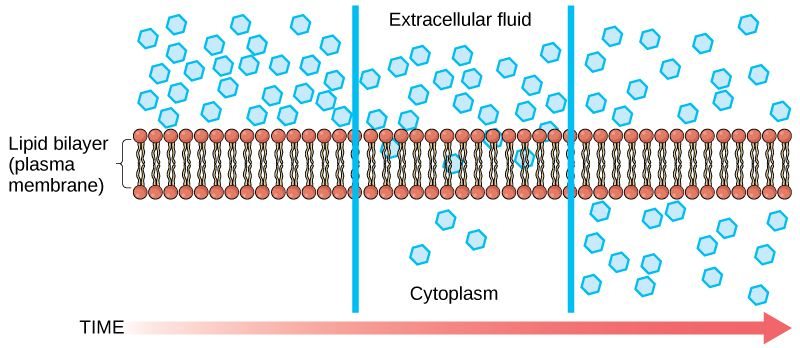
Each separate substance in a medium, such as the extracellular fluid, has its own concentration gradient, independent of the concentration gradients of other materials. Additionally, each substance will diffuse according to their unique gradients. Within a system, there will be different diffusion rates of various substances in the medium.
Molecules move constantly in a random manner, at a rate that depends on their mass, their environment, and the amount of thermal energy they possess, which in turn is a function of temperature. This movement accounts for molecule diffusion through whatever medium in which they are localized. A substance moves into any space available to it until it evenly distributes itself throughout. After a substance has diffused completely through a space, removing its concentration gradient, molecules will still move around in the space in Brownian motion, but there will be no net movement of the number of molecules from one area to another. We call this lack of a concentration gradient in which the substance has no net movement dynamic equilibrium. While diffusion will go forward in the presence of a substance’s concentration gradient, several factors affect the diffusion rate:
- Extent of the concentration gradient. The greater the difference in concentration, the more rapid the diffusion. The closer the distribution of the material gets to equilibrium, the slower the rate of diffusion becomes.
- Mass of the molecules diffusing. Heavier molecules move more slowly than lighter molecules, because it is more difficult for the heavier molecules to move between the molecules of the substance they are moving through; therefore, heavier molecules diffuse more slowly than light ones.
- Temperature. Higher temperatures increase the energy of moving particles and therefore the movement of the molecules, increasing the rate of diffusion. Lower temperatures decrease the molecules’ energy, thus decreasing the diffusion rate.
- Solvent density. As the density of the solvent increases, the rate of diffusion decreases. The molecules slow down because they have a more difficult time getting through the denser medium. If the medium is less dense, diffusion increases. Because cells primarily use diffusion to move materials within the cytoplasm, any increase in the cytoplasm’s density will inhibit the movement of the materials. An example of this is a person experiencing dehydration. As the body’s cells lose water, the diffusion rate decreases in the cytoplasm, and the cells’ functions deteriorate. Neurons tend to be very sensitive to this effect. Dehydration frequently leads to unconsciousness and possibly coma because of the decrease in diffusion rate within the cells.
- Solubility of the solute. As we discussed earlier, nonpolar or lipid-soluble materials pass through plasma membranes more easily than polar materials, allowing a faster diffusion rate.
- Surface area and plasma membrane thickness. Increased surface area increases the diffusion rate; whereas, a thicker membrane reduces it.
- Distance travelled. The greater the distance that a substance must travel, the slower the diffusion rate. This places an upper limitation on cell size. A large, spherical cell will die because nutrients or waste cannot reach or leave the cell’s centre, respectively. Therefore, cells must either be small in size, as in the case of many prokaryotes, or be flattened, as with many single-celled eukaryotes.
A variation of diffusion is the process of filtration. In filtration, material moves according to its concentration gradient through a membrane. Sometimes pressure enhances the diffusion rate, causing the substances to filter more rapidly. This occurs in the kidney, where blood pressure forces large amounts of water and accompanying dissolved substances, or solutes, out of the blood and into the renal tubules. The diffusion rate in this instance is almost totally dependent on pressure. One of the effects of high blood pressure is the appearance of protein in the urine, which abnormally high pressure “squeezes through.”
For an animation of the diffusion process in action, view this short video on cell membrane transport.

Facilitated Transport
In facilitated transport, also called facilitated diffusion, material moves across the plasma membrane with the assistance of transmembrane proteins down a concentration gradient (from high to low concentration) without the expenditure of cellular energy. Energy is not required because the concentration gradient is a form of potential energy. Materials diffuse spontaneously from high to low concentration. However, the substances that undergo facilitated transport would otherwise not diffuse easily or quickly across the plasma membrane. These materials are polar molecules or ions that the cell membrane’s hydrophobic parts repel. The method to moving polar substances and other substances across the plasma membrane rests in the transmembrane proteins that span its surface. The material being transported is first attached to protein or glycoprotein receptors on the exterior surface of the plasma membrane. This allows the material that is needed by the cell to be removed from the extracellular fluid. The substances are then passed to specific integral proteins that facilitate their passage, because they form channels or pores that allow certain substances to pass through the membrane. The integral proteins involved in facilitated transport are collectively referred to as transport proteins, and they function as either channels for the material or carriers. Some of these integral proteins are collections of beta-pleated sheets that form a pore or channel through the phospholipid bilayer. Others are carrier proteins which bind with the substance and aid its diffusion through the membrane. Facilitated transport proteins shield these materials from the membrane’s repulsive force, allowing them to diffuse into the cell.
Channels are specific for the transported substance. Channel proteins have hydrophilic domains exposed to the intracellular and extracellular fluids. In addition, they have a hydrophilic channel through their core that provides a hydrated opening through the membrane layers (Figure 7.6). Passage through the channel allows polar compounds to avoid the plasma membrane’s nonpolar central layer that would otherwise slow or prevent their entry into the cell. Aquaporins are channel proteins that allow water to pass through the membrane at a very high rate.
Channel proteins are either open at all times or they are “gated,” which controls the channel’s opening. When a particular ion attaches to the channel protein it may control the opening, or other mechanisms or substances may be involved. In some tissues, sodium and chloride ions pass freely through open channels; whereas, in other tissues a gate must open to allow passage. An example of this occurs in the kidney, where there are both channel forms in different parts of the renal tubules. Cells involved in transmitting electrical impulses, such as nerve and muscle cells, have gated channels for sodium, potassium, and calcium ions in their membranes. Opening and closing these channels changes the relative concentrations on opposing sides of the membrane of these ions, resulting in facilitating electrical transmission along nerve cell membranes or in muscle contraction.

Another type of protein embedded in the plasma membrane is a carrier protein. This aptly named protein binds a substance and, thus triggers a change of its own shape, moving the bound molecule from the cell’s outside to its interior (Figure 7.7). Depending on the gradient, the material may move in the opposite direction. Carrier proteins are typically specific for a single substance. This selectivity adds to the plasma membrane’s overall selectivity. Scientists poorly understand the exact mechanism for the change of shape. Proteins can change shape when their hydrogen bonds are affected, but this may not fully explain this mechanism. Each carrier protein is specific to one substance, and there are a finite number of these proteins in any membrane. This can cause problems in transporting enough material for the cell to function properly. When all of the proteins are bound to their ligands, they are saturated and the rate of transport is at its maximum. Increasing the concentration gradient at this point will not result in an increased transport rate.
This illustration (Figure 7.7) shows a carrier protein embedded in the membrane with an opening that initially faces the extracellular surface. After a substance binds the carrier, it changes shape so that the opening faces the cytoplasm. After the conformational change, the substance is released into the cytoplasm. An example of this process occurs in the kidney. In one part, the kidney filters glucose, water, salts, ions, and amino acids that the body requires. This filtrate, which includes glucose, then reabsorbs in another part of the kidney. Because there is only a finite number of carrier proteins for glucose, if more glucose is present than the proteins can handle, the excess is not transported and the body excretes this through urine. In a diabetic individual, the term is “spilling glucose into the urine.” A different group of carrier proteins, glucose transport proteins, or GLUTs, are involved in transporting glucose and other hexose sugars through plasma membranes within the body.
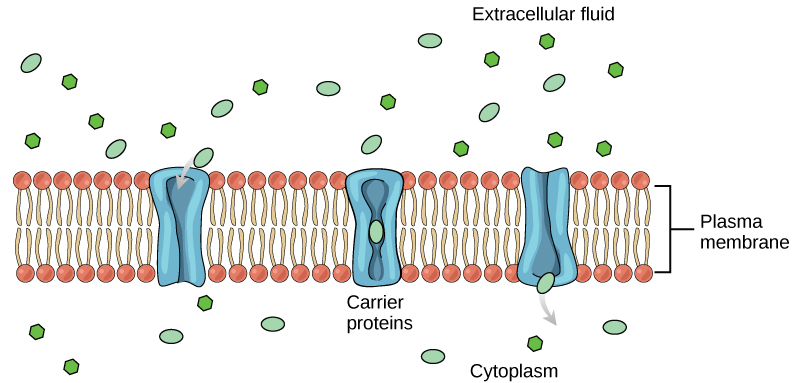
Channel and carrier proteins transport material at different rates. Channel proteins transport much more quickly than carrier proteins. Channel proteins facilitate diffusion at a rate of tens of millions of molecules per second; whereas, carrier proteins work at a rate of a thousand to a million molecules per second.
Osmosis
Osmosis is a special case of diffusion. A principle of diffusion is that the molecules move around and will spread evenly throughout the medium if they can. However, only the material capable of getting through the membrane will diffuse through it. Osmosis is the diffusion of water through a semipermeable membrane according to the concentration gradient of water across the membrane, which is inversely proportional to the solutes’ concentration. Whereas diffusion transports material across membranes and within cells, osmosis transports only water across a membrane and the membrane limits the diffusion of solutes in the water.
Water can have a “concentration.” To illustrate this, imagine two full water glasses. One has a single teaspoon of sugar in it; whereas, the second one contains one-quarter cup of sugar. If the total volume of the solutions in both cups is the same, which cup contains more water? Because the large sugar amount in the second cup takes up much more space than the teaspoon of sugar in the first cup, the first cup has more water in it.
Water, like other substances, moves from an area of higher concentration to one of lower concentration. Imagine a beaker with a semipermeable membrane, separating the two sides or halves (Figure 7.8). On both sides of the membrane, the water level is the same, but there are different concentrations on each side of a dissolved substance, or solute, that cannot cross the membrane (otherwise the solute crossing the membrane would balance concentrations on each side). If the volume of the water is the same, but the concentrations of solute are different, then there are also different concentrations of water, the solvent, on either side of the membrane. Therefore, water will diffuse down its concentration gradient, crossing the membrane to the side where it is less concentrated. This diffusion of water through the membrane—osmosis—will continue until the concentration gradient of water goes to zero or until the water’s hydrostatic pressure balances the osmotic pressure. Osmosis proceeds constantly in living systems. Not surprisingly, the aquaporins that facilitate water movement play a large role in osmosis, most prominently in red blood cells and the membranes of kidney tubules.
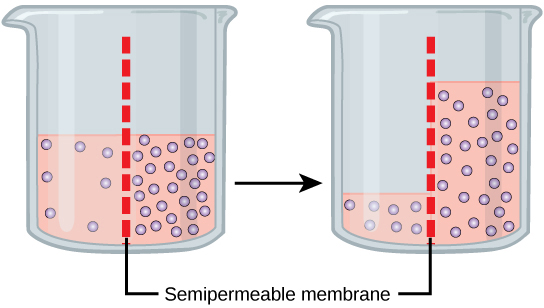
Tonicity
Tonicity describes how the amount of extracellular solute in solution affects cell volume by osmosis. The measure of the tonicity of a solution, or the total amount of solutes dissolved in a specific amount of solution, is called its osmolarity. Three terms—hypotonic, isotonic, and hypertonic—are used to relate the osmolarity of a cell to the osmolarity of the extracellular fluid that contains the cells. Blood cells in hypertonic, isotonic, and hypotonic solutions take on characteristic appearances (Figure 7.9).
In a hypotonic solution, such as tap water, the extracellular fluid has a lower concentration of solutes than the fluid inside the cell, and water enters the cell. In living systems, the point of reference is always the cytoplasm, so the prefix hypo– means that the extracellular fluid has a lower concentration of solutes, or a lower osmolarity, than the cell cytoplasm. It also means that the extracellular fluid has a higher concentration of water than does the cell. In this situation, water will follow its concentration gradient and enter the cell. This may cause an animal cell to burst, or lyse (Figure 7.9 right). Remember, the membrane resembles a mosaic, with discrete spaces between the molecules comprising it. If the cell swells, and the spaces between the lipids and proteins become too large, the cell will break apart.
In an isotonic solution, the extracellular fluid has the same osmolarity as the cell. If the concentration of solutes of the cell matches that of the extracellular fluid, there will be no net movement of water into or out of the cell. The cell appears normal (Figure 7.9 middle).
In a hypertonic solution (the prefix hyper– refers to the extracellular fluid having a higher concentration of solutes than the cell’s cytoplasm), the fluid contains less water than the cell does, such as seawater. Because the cell has a lower concentration of solutes, the water will leave the cell. In effect, the solute is drawing the water out of the cell. This may cause an animal cell to shrivel, or crenate (Figure 7.9 left).
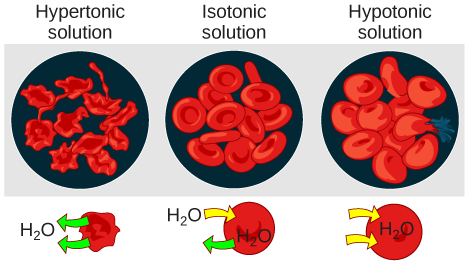
Some organisms, such as plants, fungi, bacteria, and some protists, have cell walls that surround the plasma membrane and prevent cell lysis in a hypotonic solution. The plasma membrane can only expand to the limit of the cell wall, so the cell will not lyse. In fact, the cytoplasm in plants is always slightly hypertonic compared to the cellular environment, and water will always enter a cell if water is available. This influx of water produces turgor pressure, which stiffens the cell walls of the plant (Figure 7.10). In nonwoody plants, turgor pressure supports the plant. If the environment surrounding plant cells become hypertonic, as occurs in drought or if a plant is not watered adequately, water will leave the cell. In this condition, the cell does not shrink because the cell wall is not flexible. However, the cell membrane detaches from the wall and constricts the cytoplasm. We call this plasmolysis. Plants lose turgor pressure in this condition and wilt.
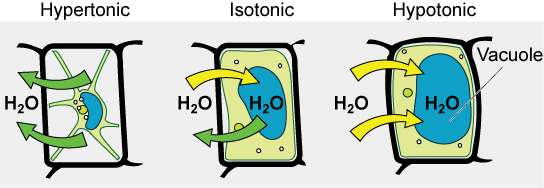
Tonicity is a concern for all living things. For example, paramecia and amoebas, which are protists that lack cell walls, have contractile vacuoles. This vesicle collects excess water from the cell and pumps it out, keeping the cell from lysing as it takes on water from its environment
Many marine invertebrates have internal salt levels matched to their environments, making them isotonic with the water in which they live. Fish, however, must spend approximately five percent of their metabolic energy maintaining osmotic homeostasis. Freshwater fish live in an environment that is hypotonic to their cells. These fish actively take in salt through their gills and excrete diluted urine to rid themselves of excess water. Saltwater fish live in the reverse environment, which is hypertonic to their cells, and they secrete salt through their gills and excrete highly concentrated urine.
In vertebrates, the kidneys regulate the water amount in the body. Osmoreceptors are specialized cells in the brain that monitor solute concentration in the blood. If the solute levels increase beyond a certain range, a hormone releases that slows water loss through the kidney and dilutes the blood to safer levels. Animals also have high albumin concentrations, which the liver produces, in their blood. This protein is too large to pass easily through plasma membranes and is a major factor in controlling the osmotic pressures applied to tissues.
Section Summary
The passive forms of transport, diffusion and osmosis, move material of small molecular weight. Substances diffuse from areas of high concentration to areas of low concentration, and this process continues until the substance is evenly distributed in a system. In solutions of more than one substance, each type of molecule diffuses according to its own concentration gradient. Many factors can affect the rate of diffusion, including concentration gradient, the sizes of the particles that are diffusing, and the temperature of the system.
In living systems, diffusion of substances into and out of cells is mediated by the plasma membrane. Some materials diffuse readily through the membrane, but others are hindered, and their passage is only made possible by protein channels and carriers. The chemistry of living things occurs in aqueous solutions, and balancing the concentrations of those solutions is an ongoing problem.
Exercises
Glossary
concentration gradient: an area of high concentration across from an area of low concentration
diffusion: a passive process of transport of low-molecular weight material down its concentration gradient
facilitated transport: a process by which material moves down a concentration gradient (from high to low concentration) using integral membrane proteins
hypertonic: describes a solution in which extracellular fluid has higher osmolarity than the fluid inside the cell
hypotonic: describes a solution in which extracellular fluid has lower osmolarity than the fluid inside the cell
isotonic: describes a solution in which the extracellular fluid has the same osmolarity as the fluid inside the cell
osmolarity: the total amount of substances dissolved in a specific amount of solution
osmosis: the transport of water through a semipermeable membrane from an area of high water concentration (low solute concentration) to an area of low water concentration (high solute concentration)
passive transport: a method of transporting material that does not require energy input
selectively permeable: the characteristic of a membrane that allows some substances through but not others
solute: a substance dissolved in another to form a solution
tonicity: the amount of solute in a solution
Media Attributions
- Figure 7.5 modification of work by Mariana Ruiz Villareal
- Figure 7.6 modification of work by Mariana Ruiz Villareal
- Figure 7.7 modification of work by Mariana Ruiz Villareal
- Figure 7.9 by Tag, A., Rao, A., Hawkins, A and Fletcher, S. Department of Biology, Texas A&M University
- Figure 7.10 modification of work by Mariana Ruiz Villareal

